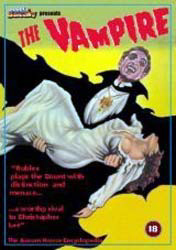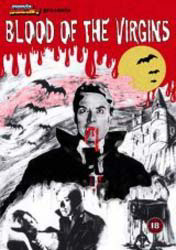| Release List | Reviews | Price Search | Shop | Newsletter | Forum | DVD Giveaways | Blu-Ray/ HD DVD | Advertise |
| Reviews & Columns |
|
Reviews DVD TV on DVD Blu-ray International DVDs Theatrical Reviews by Studio Video Games Features Collector Series DVDs Easter Egg Database Interviews DVD Talk TV DVD Talk Radio Feature Articles Columns Anime Talk DVD Savant HD Talk Horror DVDs Silent DVD
|
DVD Talk Forum |
|
|
| Resources |
|
DVD Price Search Customer Service #'s RCE Info Links |
|
Columns
|
 |
Savant Pal All Region Guest Reviews:
The Vampire |

|
The Vampire Mondo Macabro 1957 / b&w / 1:33 flat / 85 min. / El Vampiro Starring Abel Salazar, German Robles, Ariadna Welter, Carmen Montejo, Alicia Montoya, Jose Luis Jimenez, Mercedes Soler, Jose Chavez, Julio Daneri, Amado Zumaya Cinematography Rosalio Solano Art Direction Gunther Gerszo Editor Jose W. Bustos Original Music Gustavo C. Carrion Written by Ramon Obon Produced by Abel Salazar Directed by Fernando Mendez |
Released a full year before Horror of Dracula, it subsequently became something of a cliché for those in the know to cite The Vampire as being the film that most effectively bridged the cinematic generation gap between Hammer's offering and Universal's original Bela Lugosi vehicle. Well, it seems they were right: The Vampire does somehow manage to fuse key elements from both films while wilfully ignoring most of Bram Stoker's traditional Dracula narrative and boldly reaching out for something quite new plot-wise. There's much in the way of surprises, and a fair amount of suspense, to be found here.
The Vampire boasts some magnificent sets that beg favourable comparison to Universal's grand constructions. Fog-enveloped woodland and cobweb strewn Gothic archways and dusty balcony supports are expertly used by director Fernando Mendez to frame much of the film's action. These wonderfully atmospheric sets are further enhanced by the film's superbly executed black and white photography.
But while the general feel of the film largely resembles the US horror mainstream of, say, the late 1940s to the mid 1950s, the 'vampiric tone' of the show is right up there with early Hammer and beyond. German Robles brilliantly portrays the vampire Duval with both the aristocratic air of Lugosi and the powerful and menacing presence of Christopher Lee. Robles gets more 'conversational' lines than Lee and many of these are delivered with the aloofness and arrogance of Robert Quarry's Count Yorga. Curiously, the English dub gives Duval a quite Quarry-like voice. Duval also knows how to turn on the charm but when he drops his guard he is revealed to be a disturbingly callous and opportunist operator. Carmen Montejo is perfect as the female vampire: sinister and sly yet subtly sensual. She really starts to smoulder whenever Duval is close by, clearly relishing being held in his thrall.
Producer Abel Salazar is convincing as Enrique, a typically 1940s/1950s type of hero: kind of like an easy-going Robert Mitchum-type with just a dash of Dean Martin-esque comic relief/humour thrown in for good measure. He's not at all happy when it becomes clear that there really might be a vampire prowling the locality but he winds up sticking around and getting involved in the action-packed finale. Ariadna Welter is equally good as Marta. With her period haircut, caterpillar eyebrows and 1950s fashions, she resembles, at a glance, Sherilyn Fenn's Audrey Horne character from Twin Peaks. Alicia Montoya's intense performance as the eerily dishevelled Maria adds much to the film's spooky atmosphere.
The film's quite original and completely engrossing plot features just about everything anybody could want from a good vampire film: a sinister man-servant, a mysterious shipment of soil from Hungary, scenarios that reveal that the vampires have no reflections, some neat transformations into bats and spectral dematerializations, telepathic communication between the vampires, long walks through dark woods, a Son of Dracula-style surname puzzle and even a couple of specific nods in the direction of F.W. Murnau's Nosferatu. And it's all enhanced by some fantastically dramatic and expressive music. Well paced and boasting some nice camera moves and lighting effects, it's hard to find fault with any of this film's technical aspects. The Vampire fully deserves its reputation as a horror classic.
Presented full-frame, the print used here is in pretty good condition given the film's age and relative obscurity. There's an ever-so-slight wobble to parts of the picture near the start of the show and the odd outbreak of fine scratches and speckling but none of these pose a real problem. The picture is generally clear and sharp and the reproduction of the black and white photography is mostly excellent. The sound is pretty good, too. The film is presented in Spanish with removable English subtitles but the disc also holds an English language dialogue track as well. I actually found the English dub to be quite acceptable. A photonovel of the film's sequel, The Vampire's Coffin (El Ataud del Vampiro), can be found in the disc's extra features section. The intriguing documentary on Mexican horror films presented here is the same one that appeared on Mondo Macabro's DVD of Alucarda. This is a PAL disc but it is encoded for 'All Regions'.

|
Blood of the Virgins Mondo Macabro 1967 / colour / 1:33 flat / 75 min. / Sangre de Virgenes Starring Ricardo Baulex, Susana Beltram, Gloria Prat, Raoul Monroy, Walter Kliche, Milton Ghio, Mariella Albano, Jiustin Martin, Marta Peiran, Albina Malagola, Silvano Roncatti, Nilo Conti Cinematography Anibal Gonzales Paz Editor Oscar Ronet Original Music Victor Buchino Written by Emilio Vieyra and Raúl Zorrilla Produced by Oreste Trucco Directed by Emilio Vieyra |
Argentina's very first vampire film opens with great promise: its prologue's period costumes and sets give it the look and feel of a fairly typical Hammer film. And Gustavo is introduced as a quite intriguing and distracted vampire. Spurned by Ofelia because he refuses to explain why he cannot present himself to her parents, he selfishly wrecks her wedding night and bestows vampiric immortality upon her against her will. The prologue ends with a be-fanged and clearly disorientated Ofelia reluctantly emerging from her tomb in order to begin her new life with the waiting Gustavo. The film's credits then play against a series of macabre, semi-animated, modern art picture graphics that are really quite impressive, bringing to mind the more outlandish pieces used in the introductions to Rod Serling's Night Gallery.
An extended montage of hip teenagers at play brings the film's narrative bang up to the present day (1967). These kids party hard and the action flips back and forth between scenes which show the groovers messing around on a ski slope (a nice tribute to The Beatles' similar shenanigans in Richard Lester's Help!), partying on a cruise ship, making out in the woods, getting wild in a night club, etc. The nightclub sequences, which climax with one of the girls go-go dancing topless on the bar, and the woodland sequences have a definite Russ Meyer feel about them. The whole montage is quite nicely edited, in a sub-psychedelic kind of way, to the interchanging rhythms of twangy guitar-led beat music and fairly strange muzak. But when the kids run out of petrol on the way home and elect to spend the night in a house that their elder-beatnik guru has warned them is haunted, the fun really starts.
It's clear that Vieyra approached this project with his feet still firmly rooted in fairly strong (for its day) sexploitation and exploitation cinema: the nude scenes here resemble Hammer's racy early 70s output and there are two bursts of bloodletting at either end of the film that are as graphic as the mainstream horror stuff of the late 70s. That said, both the nudity and the violence play reasonably unforced, occupying fairly legitimate spaces within the film's story arc: basically, Ofelia needs to bond with the right earthly lover in order to summon up the mystical power needed to break her supernatural link with Gustavo, thus bringing an end to her unhappy existence as a reluctant immortal. Vieyra's rehashes of two other popular genre themes, the ill-fated teens in a haunted house scenario and the subsequent, loosely Dracula-inspired vampiric activity, are fairly well observed and are detailed enough for Blood of the Virgins to play like a genuine attempt at a serious horror film as opposed to a cynical sexploitation or exploitation quickie knock-off.
But that's not to say that Blood of the Virgins is a great horror film. It was clearly shot on a small budget and some of its technical aspects can't help but bring to mind the shaky ambience of horror B movies from the 1950s. And the film boasts a number of subplots that simply don't make much sense. Ultimately, there's a touch of Ed Wood about some of the proceedings presented here. But everybody involved, even the most obviously non-professional of the actors, enters into the project with much gusto and enthusiasm and that counts for a lot with this particular reviewer.
Much mirth has been made in some quarters with regard to Vieyra using red-tinted shots of flying seagulls to signal impending vampiric activity but these sequences, with their soundtrack of strange electronic noises, worked fine for me. (Spoiler....) And the film boasts a stunning, if audacious, final plot twist which involves Gustavo's spooky man-servant suddenly appearing, just as our heroes have driven off believing that the mystery has been solved and the supernatural danger laid to rest. If this sequence had been held back, and used instead as a prologue to a sequel, it would have easily equalled the best of both Universal's and Hammer's series-extending scenarios! (....spoiler ends).
A world-wide video premiere struck from the original negative, the picture quality of this full-frame DVD presentation is really very good. It's sharp and colourful and is only really let down by the odd appearance of scratches, some of which are of the vertical tramline variety. But none of these scratches are particularly deep or distracting. The sound is also very good, presenting a Spanish dialogue track with removable English subtitles. The Mondo Macabro documentary about Argentinean exploitation cinema is an interesting extra. This is a PAL disc but it is encoded for 'All Regions'.
Both discs are PAL, and are not intended for playback in the U.S.
On a scale of Excellent, Good, Fair, and Poor,
The Vampire rates:
Movie: Excellent
Video: Very good
Sound: Very Good
Supplements: Mondo Macabro documentary about Mexican horror films and a photonovel
presentation of The Vampire's Coffin (El Ataud del Vampiro).
Packaging: Keep case
Reviewed: January 7, 2003
On a scale of Excellent, Good, Fair, and Poor,
Blood of the Virgins rates:
Movie: Fair
Video: Very Good+
Sound: Very Good+
Supplements: Mondo Macabro documentary about Argentinean exploitation films and
text production notes by Pete Tombs
Packaging: Keep case
Reviewed: January 7, 2003
Review Staff | About DVD Talk | Newsletter Subscribe | Join DVD Talk Forum
Copyright © MH Sub I, LLC dba Internet Brands. | Privacy Policy | Terms of Use
|
| Release List | Reviews | Price Search | Shop | SUBSCRIBE | Forum | DVD Giveaways | Blu-Ray/ HD DVD | Advertise |





